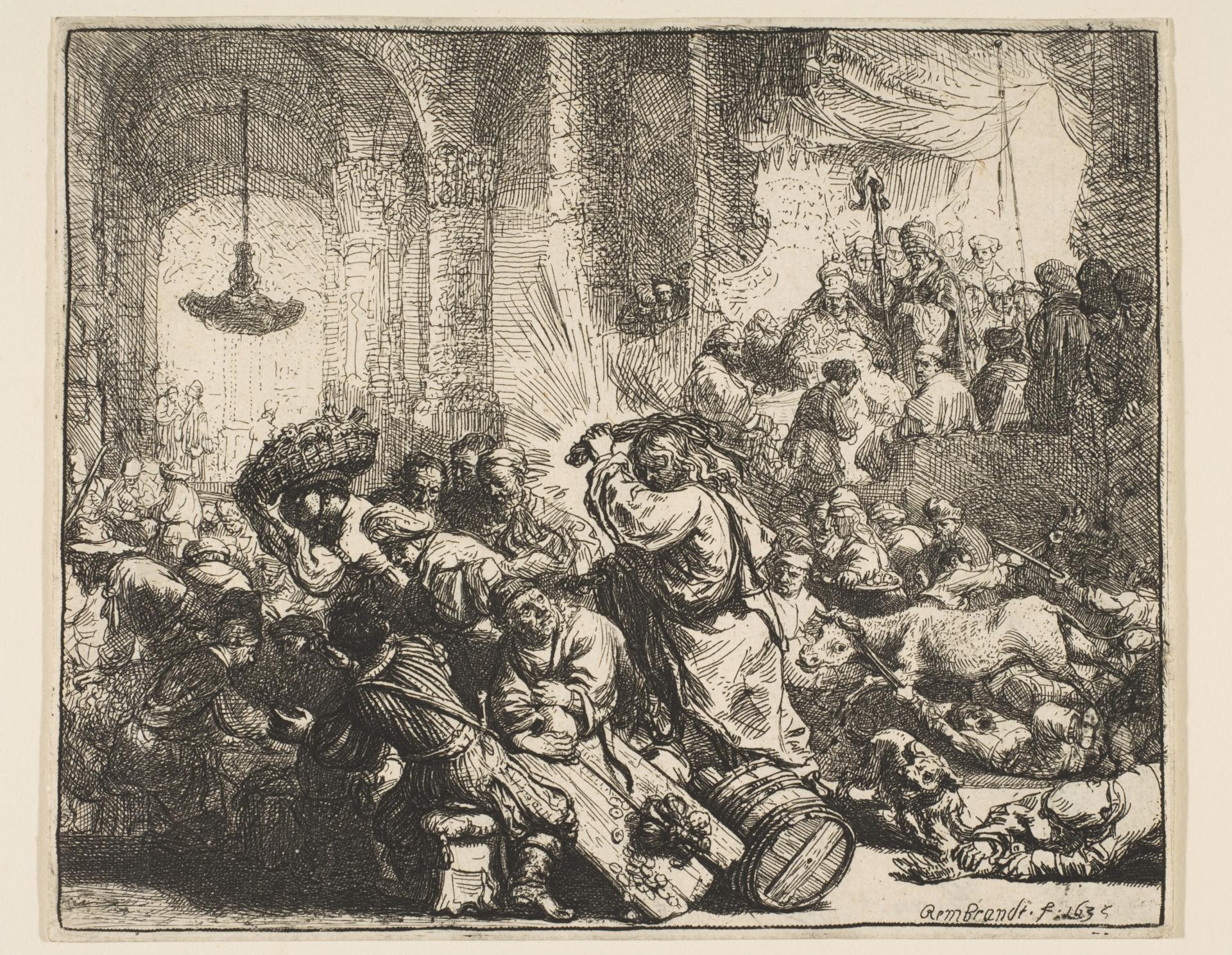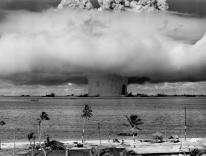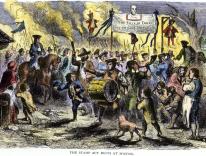Interested in discussing this article in your classroom, parish, reading group, or Commonweal Local Community? Click here for a free discussion guide.
The whip is held high in Christ’s hand, and a man in a loose yellow robe braces for the blow. Other merchants cower or scramble to gather their possessions. Their bodies are contorted, their clothes bright, their faces full of fear. Nearby, Pharisees debate the coming violence, but Christ himself looks calm, serene, without a trace of anger in his face. We don’t see the blow land. And so we must imagine exactly how hard he strikes, since the moment El Greco depicts in Purification of the Temple is itself bloodless. No bruises, no scars, no bleeding flesh. We picture the righteous rage that lifted the whip, not the aftermath.
As a young man standing before this painting in the Frick Museum during the winter of 2006, I found it comforting. I was on leave visiting family, about to head to Iraq with the Marine Corps. I imagined that this painting, and the story from the gospels behind it, allowed my decision to serve in the military to sit comfortably with my faith. Here was Christ, “turn the other cheek,” “blessed are the peacemakers” Christ, doing violence.
It seemed to open the door to other kinds of violence. And though my particular job in the Marine Corps would likely be a safe, nonviolent one, the same could not be said for the enterprise to which I’d be contributing. Justification was required, both for the specific enterprise and for the thrill and fascination it held for me.
Violence was something I’d always enjoyed. The aestheticized violence of action movies, of course, but also the controlled violence of sport. I was a boxer and a rugby player. Those sports offered me ample opportunity to give and receive both pain and (usually) minor injury. Once, on a rugby tour in Canada, we engaged in a scrum with the opposing team and managed to push the Canadians back with enough force that they started backpedaling until one of the opposing players got caught in an odd position. We pressed forward; he began screaming in pain. We delightedly pushed harder. Fun. And boxing, of course, delivered such visceral satisfactions much more regularly (alongside humiliations, like the only fight my now-wife ever attended, about which you can guess the outcome).
The violence in Iraq was considerably more serious, the stakes higher, hence my desire for an image of righteous violence untroubled by horror. The text itself, though, from John 2, doesn’t have much horror. It is a rather restrained depiction of supposed violence.
The Passover of the Jews was near, and Jesus went up to Jerusalem. In the temple he found people selling cattle, sheep, and doves, and the money changers seated at their tables. Making a whip of cords, he drove all of them out of the temple, both the sheep and the cattle. He also poured out the coins of the money changers and overturned their tables. He told those who were selling the doves, “Take these things out of here! Stop making my Father’s house a marketplace!” His disciples remembered that it was written, “Zeal for your house will consume me.”
The passage doesn’t describe a single blow. We never see the injured, need not imagine a man living with the scars from Christ’s whip. There is no aftermath.
I went to Iraq and, because I was a Public Affairs Officer, doing my mostly safe job in a mostly safe part of a very dangerous place, that aftermath was my only experience of violence—the injured civilians (civilians always suffer the most in wars) alongside Marines and enemy combatants treated by my unit’s surgical platoon. There is no thrill in seeing such things. The horribly injured body of your enemy looks like any other human body, their pain no more pleasant to observe.
Our unit also contained the Mortuary Affairs unit, Marines whose job was to prepare the bodies of the dead to be sent home, a task that involves carefully preparing not simply the body (or body parts), but also the personal effects, the things that a Marine brought with him to war and that often spoke in a soft voice of his specific humanity outside of the uniform—whether it was through a sonogram kept in a pocket, or a prodigious stack of porn kept in a trunk. Someone in Mortuary Affairs told my sergeant a story of a Marine whose Humvee had caught fire after an IED strike. This Marine had made it outside the vehicle only to die in flames on the side of the road, and when his body came in, his two fists were tightly clutched around something, they didn’t know what.
The Mortuary Affairs Marine went to work, carefully prying the burned fingers back, trying not to snap them off. What was the dead man holding? What, in his last hour, was the thing he clutched onto? A cross, perhaps? A good luck charm sent by a loved one? No, it was just some rocks. The Marine, in flames, had fallen to the desert and clutched in agony at whatever he could, clutched so hard that the points of the rocks that had been lying there were embedded in his flesh. They were a testament to nothing more than human agony.
For the great Church Father Origen, the story doesn’t add up. First off, he’s pretty sure that if Jesus tried to drive out a group of merchants with a whip, he probably would have been the one getting whupped. “And who that received a blow from the scourge of small cords…would not have attacked him and raised a cry and avenged himself with his own hand, especially when there was such a multitude present who might all feel themselves insulted by Jesus in the same way?”
But there’s a bigger problem. “To think, moreover, of the Son of God taking the small cords in his hands and plaiting a scourge out of them for this driving out from the temple,” Origen says, “does it not bespeak audacity and temerity and even some measure of lawlessness?” Jesus was no brawler. To fully imagine this scene means imagining a Christ at odds with the one we repeatedly encounter in the rest of the gospels.
Origen’s solution is to turn the whole thing into an allegory. The temple is “the soul skilled in reason,” the whip is Jesus’ “word plaited out of doctrines of demonstration and rebuke,” the ox is “earthly things,” the poor sheep are “senseless and brutal things” (what did sheep ever do to Origen?), and the doves are “empty and unstable thoughts.” If this interpretation seems dubious, well…tough. If it isn’t allegory, then “we must say that the passage would otherwise have an unlikely air.”
There’s something very appealing about this mode of Biblical analysis—if you don’t like a story in the gospels, just decide it means something totally different. As a child, I heard a priest (later arrested for embezzling parish funds to feed a gambling addiction) deliver a sermon in which he claimed that when Jesus said, “it is easier for a camel to go through the eye of a needle than for a rich man to enter the kingdom of God,” he was referring not to an actual needle. That would make the passage far too radical. Instead, he claimed, it referred to a gate in Jerusalem called “the Eye of a Needle,” which, while small and narrow and difficult, could nevertheless allow a camel to shove his way through. Jeff Bezos’s afterlife, then, need not be a freefall into hellfire but something more like crossing the crowded floor of a dancehall: awkward but doable. The theological term for this style of biblical interpretation is bullshit. Christ being, after all, pretty radical, most people who call themselves Christian, myself included, couldn’t look ourselves in the mirror without it.
That’s why it’s not so surprising that before Christianity came to power (after Constantine saw the words “under this sign you will conquer” written in the sky, announcing the marriage of the Church and state violence), many of the Church Fathers were more uncompromising. “The whole world is wet with mutual blood; and murder,” says Cyprian of Carthage, “which in the case of an individual is admitted to be a crime, is called a virtue when it is committed wholesale.” “The catechumen or faithful who wants to become a soldier is to be rejected, for he has despised God,” says Hippolytus. “We who formerly used to murder one another do not only now refrain from making war upon our enemies,” writes Justin Martyr, “but also, that we may not lie nor deceive our examiners, willingly die confessing Christ.” “Shall it be held lawful to make an occupation of the sword, when the Lord proclaims that he who uses the sword shall perish by the sword?” Tertullian asks, before declaring, “A state of faith admits no plea of necessity.”
But the Church Fathers were not quite pacifists, as is sometimes claimed. Tertullian, for example, still prays for “security to the empire” and “for brave armies”—he’d just prefer the fighting be done by pagans. Or, as Origen put it in the second century, “While others go out to war, we, as priests and servants of God, take part in the campaign in that we keep our hands clean and pray for the just cause.” In this regard, they’re like some of our modern elites. The richest 20 percent of zip codes in America are heavily underrepresented in the mostly middle-class military, and I’ve been asked more times than I can count, “Why would you join the military after Dartmouth? You had options!” If the fighting must be done, let it be done by lesser people.
As the pagan world faded, though, Christians increasingly had to do the fighting themselves. And bloody hands, Christians worried, could mean spiritual death. “Whenever you March out, O worldly warrior,” wrote Bernard of Clairvaux, “you have to worry that killing your foe’s body may mean killing your soul, or that by him you may be killed, body and soul both.” As Philip G. Porter recently pointed out in these pages, early medieval Penitentials often imposed penances on soldiers who killed in war, regardless of whether the cause was just (“War & Penance,” January). “Homicide in war is not reckoned by our Fathers as homicide,” noted St. Basil the Great, one of the doctors of the Church, “Perhaps, however, it is well to counsel that those whose hands are not clean only abstain from Communion for three years.” Pope Gregory VII argued “it is impossible to engage in military service without sin,” though he also argued that “knights undergoing penance could nevertheless fight to defend justice on the advice of their bishops.” You can fight and kill, but as Philo Judaeus pointed out, those you kill share “a supreme and common relationship to a common father.” This is not the triumphant violence of American popular culture, but a more tragic vision, in which doing what needs to be done doesn’t always leave us untarnished.
So perhaps Christ, the untarnished one, didn’t do any violence at all. Scholars like Andy Alexis-Baker and N. Clayton Croy follow a tradition dating back to the sixth century, when Cosmas Indicopleustes argued that, if one pays close attention to the text of John’s Gospel, it does not actually say that Christ struck people.
He struck the brute beasts only, as it is written: “And having made a whip of cords he expelled all from the temple, both the sheep and the cattle.” That is to say: He struck these as living but irrational creatures…. But the rational beings he neither struck nor pushed away, but chastised with speech, as it is written: “And to those who sold doves he said, ‘Take these things hence, and do not make my Father’s house a marketplace.’”
In this reading, the key phrase in the passage is what is known as a partitive appositive, in which the “all” refers to the items in the next clause. The difference can be seen in the King James Version’s “and when he had made a scourge of small cords, he drove them all out of the temple, and the sheep, and the oxen,” in contrast to the NRSV translation: “Making a whip of cords, he drove all of them out of the temple, both the sheep and the cattle.”
In this modern translation, the makeshift whip is only for the animals, since, as Ernst Haenchen pointed out, “one cannot drive animals with hands alone.” Craig Keener argues that narratively, the idea that Jesus is using the whip on people makes no sense, since immediately after he is described as using the whip he addresses the dove sellers and commands them to pack up.
In Alexis-Baker’s telling, the definitive break with early nonviolent readings of the scene comes with Augustine. The Donatist Petilian had complained that Catholics were violating Christ’s teachings by engaging in violence. “The Lord Christ drove out the shameless merchants from the temple with whippings,” Augustine responded. “So we find…Christ a persecutor…. Christ even bodily persecuted those whom he expelled from the temple.”
Christ as persecutor—you can hear a sigh of relief across the centuries, as this development allows us to sanctify our darkest desires. It appears in Bernard of Clairvaux’s argument that crusaders are “animated by the same zeal for the house of God which of old passionately inflamed their leader himself when he armed his most holy hands, not indeed with a sword, but with a whip.” It appears in John Calvin’s use of this Gospel passage to defend his role in burning Michael Servetus at the stake. And it was there in my own rather dubious comfort as I stood before El Greco’s serenely violent interpretation of the scene.
But none of that can really be blamed, I think, on grammatical ambiguity. “To move from a little whip and overturning a table to firing machine guns, missiles and other modern weaponry is simply absurd,” writes Alexis-Baker, “If Christians want to justify war and other forms of killing, they will need to look somewhere besides this passage.”

I recently found an image of the scene I much prefer, Rembrandt’s 1635 etching Christ Driving the Money Changers from the Temple (see pp. 18–19). It is a darker image, with Christ’s face deeply shadowed as he clutches the raised whip and the merchants cower in a clump. Rays of light, represented by streaking lines, emanate from a halo at the center of the image. The halo is not over Christ’s head. No, it surrounds the whip itself.
That’s what I like about the etching. That clarifying blasphemy. In the gospels, the scene seems such a challenge to our modern order, where money permeates everything and spaces for the sacred are disappearing. In the Rembrandt etching, though, we see what we have so often over the centuries preferred to worship.
Please email comments to [email protected] and join the conversation on our Facebook page.
Previous Story
Ukraine, the Vatican, and Vatican II
Next Story
‘That’s Hitler!’


